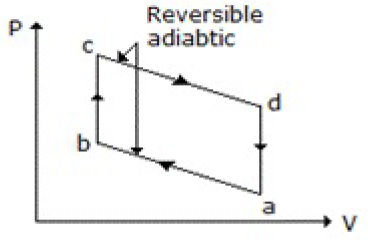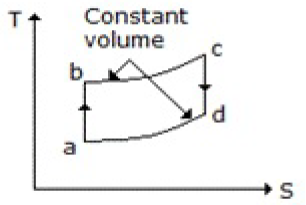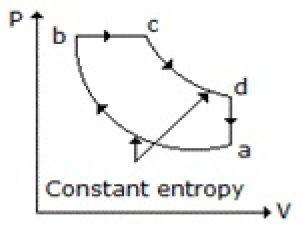In the reaction, represented by, 2SO2 + O2 2SO3; ΔH = - 42 kcal; the forward reaction will be favoured by
Low temperature
High pressure
Both (A) and (B)
Neither (A) nor (B)
Correct Answer :
C. Both (A) and (B)
Related Questions
Clausius-Clapeyron Equation gives accurate result, when the
Vapour pressure is relatively low and the temperature does not vary over wide limits
Vapour obeys the ideal gas law and the latent heat of vaporisation is constant
Volume in the liquid state is negligible compared with that in the vapour state
All (A), (B) and (C)
For an isothermal process, the internal energy of a gas
Increases
Decreases
Remains unchanged
Data insufficient, can't be predicted
In reactions involving solids and liquids (where change in volume is negligible), the heat of reaction at constant pressure as compared to that at constant volume is
More
Less
Same
Unpredictable; depends on the particular reaction
Pressure-enthalpy chart is useful in refrigeration. The change in internal energy of an ideal fluid used in ideal refrigeration cycle is
Positive
Negative
Zero
Infinity
Trouton's ratio of __________ liquids is calculated using Kistyakowsky equation.
Polar
Non-polar
Both (A) & (B)
Neither (A) nor (B)
When dilute aqueous solutions of two salts are mixed, the process is associated with
Decrease in temperature
Increase in temperature
No change in temperature
Change in temperature which is a function of composition
The ammonia synthesis reaction represented by N2 + 3H2 2NH3; ΔH = - 22.4 kcal, is
Endothermic
Exothermic
Isothermal
Adiabatic
The specific heat of saturated water vapour at 100°C is
∞
-ve
0
+ve
A gas shows deviation from ideal behaviour at
Low pressure and high temperature
Low pressure and low temperature
Low temperature and high pressure
High temperature and high pressure
On a P-V diagram of an ideal gas, suppose a reversible adiabatic line intersects a reversible isothermal line at point A. Then at a point A, the slope of the reversible adiabatic line (∂P/∂V)s and the slope of the reversible isothermal line (∂P/ ∂V)T are related as (where, y = Cp/Cv)
(∂P/∂V)S = (∂P/∂V)T
(∂P/∂V)S = [(∂P/∂V)T]Y
(∂P/∂V)S = y(∂P/∂V)T
(∂P/∂V)S = 1/y(∂P/∂V)T
Gibbs free energy (F) is defined as
F = E - TS
F = H - TS
F = H + TS
F = E + TS
Which of the following is not an intensive property?
Volume
Density
Temperature
Pressure
At normal boiling point, molar entropy of vaporisation is __________ Joule/K°.mole.
72
92
142
192
Vapour which is at a pressure smaller than the saturation pressure for the temperature involved is called a __________ vapour.
Superheated
Desuperheated
Non-condensable
None of these
Which of the following decreases with increase in pressure?
Melting point of ice
Melting point of wax
Boiling point of liquids
None of these
Joule-Thomson Co-efficient at any point on the inversion curve is
∞
+ve
0
-ve
It is desired to bring about a certain change in the state of a system by performing work on the system under adiabatic conditions.
The amount of work needed is path dependent
Work alone cannot bring out such a change of state
The amount of work needed is independent of path
More information is needed to conclude anything about the path dependence or otherwise of the work needed
Clapeyron Equation deals with the
Rate of change of vapour pressure with temperature
Effect of an inert gas on vapour pressure
Calculation of ΔF for spontaneous phase change
Temperature dependence of heat of phase transition
The internal energy of an ideal gas is a function of its __________ only.
Molecular size
Volume
Pressure
Temperature
Chemical potential of ith component of a system is given by
μi = (∂F/∂ni)T, P, ni
μi = (∂A/∂ni)T, P, ni
μi = (∂F/∂ni)T, P
μi = (∂A/∂ni)T, P
In a homogeneous solution, the activity coefficient of a component depends upon the
Pressure
Composition
Temperature
All (A), (B) and (C)
Heat requirement for decomposition of a compound into its elements is __________ that is evolved during the formation of that compound from its elements.
The same
Less than
Greater than
Different than
Clausius-Clapeyron equation is applicable to __________ equilibrium processes.
Solid-vapor
Solid-liquid
Liquid-vapor
All (A), (B) and (C)
Chemical potential (an intensive property) of a substance is a force that drives the chemical system to equilibrium and is equal to its partial molar properties. The ratio of chemical potential to free energy of a pure substance at constant temperature and pressure is
0
1
∞
None of these
For an isothermal reversible compression of an ideal gas
Only ΔE = 0
Only ΔH =0
ΔE = ΔH = 0
dQ = dE
Thermal efficiency of a Carnot engine can approach 100%, only when the temperature of the
Cold reservoir approaches zero
Hot reservoir approaches infinity
Either (A) or (B)
Neither (A) nor (B)
Lowering of condenser temperature (keeping the evaporator temperature constant) in case of vapour compression refrigeration system results in
Increased COP
Same COP
Decreased COP
Increased or decreased COP; depending upon the type of refrigerant
Which of the following diagrams does not represent an Otto cycle?



None of these
In a homogeneous solution, the fugacity of a component depends upon the
Pressure
Composition
Temperature
All (A), (B) and (C)
The melting point of paraffin wax (which contracts on solidification) __________ with pressure rise.
Increases
Decreases
Remains unchanged
Decreases linearly
